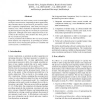Free Online Productivity Tools
i2Speak
i2Symbol
i2OCR
iTex2Img
iWeb2Print
iWeb2Shot
i2Type
iPdf2Split
iPdf2Merge
i2Bopomofo
i2Arabic
i2Style
i2Image
i2PDF
iLatex2Rtf
Sci2ools
IV
2005
IEEE
2005
IEEE
POLYMECO - A Polygonal Mesh Comparison Tool
Polygonal meshes are used in many areas to model different objects and structures. Depending on their applications, they sometimes have to be processed to, for instance, reduce their complexity (simplification). This mesh processing introduces error, whose evaluation is important when choosing the kind of processing that is to be done for a particular application. Although some mesh comparison tools are described in the literature, little attention has been given to the way results are presented. A tool is presented which enhances the way users perform mesh analysis and comparison, by providing an environment where several visualization options are available and can be used in a coordinated way.
| Added | 25 Jun 2010 |
| Updated | 25 Jun 2010 |
| Type | Conference |
| Year | 2005 |
| Where | IV |
| Authors | Samuel S. Silva, Joaquim Madeira, Beatriz Sousa Santos |
Comments (0)

